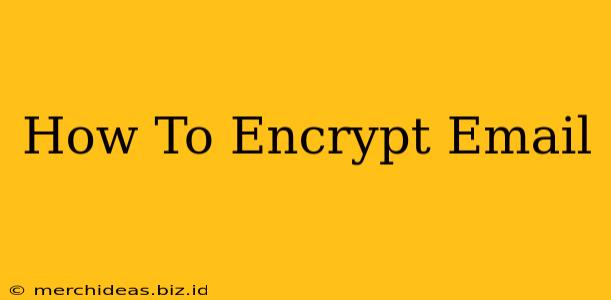In today's digital age, email remains a cornerstone of communication, both personal and professional. However, the inherent vulnerabilities of email to interception and unauthorized access are a significant concern. Learning how to encrypt your emails is crucial for protecting sensitive information, maintaining privacy, and building trust. This comprehensive guide will walk you through various methods to encrypt your emails, ensuring your messages remain confidential.
Understanding Email Encryption
Before diving into the how-to, let's clarify what email encryption is and why it matters. Email encryption is the process of scrambling your email's contents so that only the intended recipient, possessing the decryption key, can read it. Without the key, the message appears as unreadable gibberish. This protects your email from prying eyes, including hackers, internet service providers (ISPs), and even government agencies.
Why Encrypt Your Emails?
- Privacy: Protect sensitive personal information like financial details, medical records, or confidential discussions.
- Security: Safeguard against data breaches and unauthorized access, mitigating the risk of identity theft and other cybercrimes.
- Compliance: Meet regulatory requirements for data protection, especially in industries like healthcare and finance.
- Trust: Build confidence with clients and colleagues by demonstrating a commitment to secure communication.
Methods for Email Encryption
Several methods exist for encrypting your emails, each with its strengths and weaknesses. Choosing the right method depends on your technical skills, security needs, and the recipient's capabilities.
1. S/MIME (Secure/Multipurpose Internet Mail Extensions)
S/MIME is a widely used protocol that offers strong encryption using digital certificates. This method encrypts both the email body and attachments. To use S/MIME, you'll need to obtain a digital certificate from a Certificate Authority (CA). While offering robust security, S/MIME can be complex to set up and requires both sender and recipient to have compatible clients and certificates.
Pros: Strong encryption, widely supported by email clients. Cons: Complex setup, requires certificates, not always user-friendly.
2. PGP/GPG (Pretty Good Privacy/GNU Privacy Guard)
PGP/GPG is an open-source encryption standard that provides strong encryption and digital signatures. It's considered highly secure and is a popular choice for those prioritizing privacy. Unlike S/MIME, PGP/GPG doesn't rely on a central authority for certificates. Instead, it uses public and private keys, requiring key exchange between sender and recipient. This added layer of complexity, however, might make it less suitable for casual users.
Pros: Strong encryption, open-source, independent of CAs. Cons: Steeper learning curve, requires key management, more technical expertise needed.
3. End-to-End Encrypted Email Providers
Several email providers offer built-in end-to-end encryption, simplifying the process significantly. These services encrypt your emails before they leave your device, ensuring only you and the recipient can read them. Examples include ProtonMail and Tutanota. While convenient, these services might not offer the same level of flexibility as S/MIME or PGP/GPG, and reliance on a third party introduces a different set of security considerations.
Pros: Easy to use, built-in encryption, user-friendly. Cons: Reliance on a third-party provider, might have limitations on features.
Choosing the Right Encryption Method
The best encryption method for you depends on your individual needs and technical capabilities. Consider the following factors:
- Security requirements: How sensitive is the information you're sending?
- Technical expertise: Are you comfortable managing keys and certificates?
- Recipient compatibility: Does your recipient use the same encryption method?
- Ease of use: How user-friendly is the chosen method?
Conclusion: Prioritize Your Email Security
In a world increasingly reliant on digital communication, securing your emails is no longer a luxury but a necessity. By understanding the different encryption methods and choosing the one that best suits your needs, you can significantly enhance your online privacy and protect your sensitive information. Remember, proactive measures are crucial in safeguarding your digital communications. Don't hesitate to explore the options presented and take control of your email security today.
